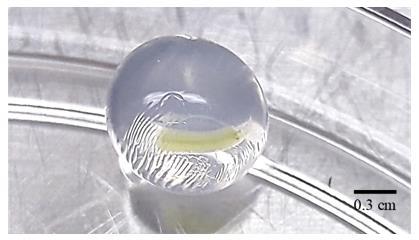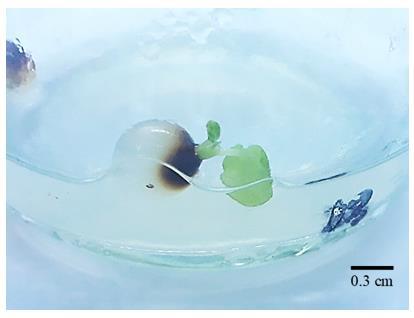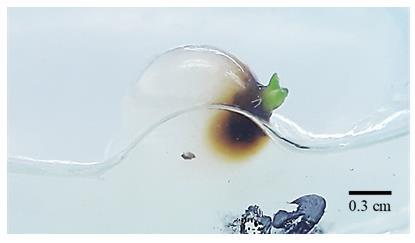ISSN 2348-313X (Print)
International Journal of Life Sciences Research ISSN 2348-3148 (online)
Vol. 8, Issue 3, pp: (15-19), Month: July - September 2020, Available at: www.researchpublish.com

ISSN 2348-313X (Print)
International Journal of Life Sciences Research ISSN 2348-3148 (online)
Vol. 8, Issue 3, pp: (15-19), Month: July - September 2020, Available at: www.researchpublish.com
Fadhlul Khaliq Ab Patah 1* , Nor Azlina Hasbullah1, Nur Shifa Radzuan1, Husna Idris1 , Mohammad Mohd
Lassim2
1Department of Agricultural Science, Faculty of Technical and Vocational (FTV), Universiti Pendidikan Sultan Idris (UPSI), Tanjong Malim, Perak, Malaysia
2
Faculty of Sustainable Agriculture (Sandakan Campus), Universiti Malaysia Sabah (UMS), 90000, Sandakan, Sabah, Malaysia
Email: khaliqpatah@gmail.com
Abstract: The advantage of producing synthetic seeds of Ficus carica L. gives a new perspective to plant breeders to see that biotechnology is actually facilitating in improving the quality and productivity of the crops. Ficus carica L. is one of the first crop that have been grown by humans for economical purposes. Conventional propagation methods of Ficus carica L. through cuttings, grafting, and air-layering have been used since the beginning until now. Another alternative of propagating Ficus carica L. is through the production of synthetic seeds. The advantages of synthetic seeds production include various aspects such as production through aseptic tissue culture producing pathogen-free seeds, providing protection to enhance growth effectiveness in the external environment, and cloning that aimed for conservation and preservation as well as its in small size, easy to handle, to transport and also stored for specific purposes. The formation of consistent, uniformed and roundly shaped bead is influenced by the concentration of sodium alginate and the concentration of hydrated calcium chloride solution used. In this study, the optimal synthetic seeds of Ficus carica L. with consistent, strong, round and uniform size were successfully produced when 4% sodium alginate containing 1.0 mg/L Benzylaminopurine (BAP) was used as the explants’ encapsulation matrix. The synthetic seeds were germinated and new plantlets obtained were grown.
Keywords: Ficus carica L., tissue culture, synthetic seeds, encapsulated bead, in vitro.
Synthetic seed technology proposes an alternative system for propagation of transgenic plants, non-seed producing plants, polyploids with elite traits and plants with problems in seed propagation [1]. A synthetic seed is defined as artificially encapsulated somatic embryos, shoot buds, cell aggregates, or any other tissue that can be used for sowing as a seed and that possess the ability to convert into a plant under in vitro or ex vitro conditions and that retains this potential also after storage [2]. There are several types of synthetic seed such as somatic embryos encapsulated in a water gel, dried and coated somatic embryos. Dried and uncoated somatic embryos, somatic embryos suspend in a fluid carrier, and shoot buds encapsulated in water gel [3]. The technology may also be of interest for storage of germplasm and transportation of selected genotypes [4]. Thus, the synthetic seed technology is best suited for the preservation of genetic structure of regenerated plants and can be stored for a long time [1].
Conventional methods in propagating Ficus carica L. such as cuttings, grafting and air layering are mainly and widely used even in the beginning of this plants have introduced to market for economically consumption. However, according to a previous study [5], the conventional methods yield production is low, limited and results in poor rooting which only 20 – 30% of cuttings were survived. The demand of Ficus carica L. fruit is increasing from time to time. The fruit of Ficus carica L. have a very high safety profile which contain numerous of nutrients including calcium, iron, magnesium, phosphorus, potassium, sodium, zinc, thiamin, riboflavin, niacin, vitamin B6, vitamin B12, vitamin A, vitamin C, and Folate [6]. The benefits and high nutritious in this fruit have caused the demand from consumers to increase despite of their low productivity per year [7]. In addition, this was in line with Malaysian Third National Agriculture Policy (DPN 3)
ISSN 2348-313X (Print)
International Journal of Life Sciences Research ISSN 2348-3148 (online)
Vol. 8, Issue 3, pp: (15-19), Month: July - September 2020, Available at: www.researchpublish.com
objectives to promote commodities which have high added values and good export potential in maximizing agriculture’s contribution to national Gross Domestic Product (GDP), export earnings as well as maximizing income of the farmers [8]. Thus, this study seeks for an alternative way in help for boosting the production of Ficus carica L. through synthetic seed production.
Micro stems of Ficus carica L. were induced from stem explants cultured on MS medium. The cultures were maintained in the culture room at 25 ± 2 °C for 16 hours light and 8 hours dark photoperiod. Illumination will at 1000 lux and relative humidity was 90 – 100%. The standard method for preparation of encapsulation matrix is followed [9].
To prepare MS [12] - sodium alginate solution, 100 ml MS basal medium without calcium chloride dihydrate (CaCl2.2H2O) and sodium alginate powder were dissolved steadily. Three grams of sucrose and hormones (optimum for shoot regeneration) were added. The pH of the media was adjusted to 6.0. The concentration of sodium alginate used in this study were 3.0 g/L, 4.0 g/L and 5.0 g/L. This solution was autoclaved for 20 minutes at 121°C [9].
Calcium chloride dihydrate solution was used as a complexion agent. To prepare 0.1M of calcium chloride dihydrate solution 2.94 grams of calcium chloride dihydrate (CaCl2.2H2O) was weighed and dissolved in 200 ml of distilled water gradually. This solution was autoclaved for 20 minutes at 121 °C [9].
Distilled water was filled up into 1000 ml of Schott bottle to dissolve 4.4 g of MS powder. The solution was stirred constantly on a magnetic-hot-plate stirrer. The solution was autoclaved for 20 minutes at 121 °C prior to obtain sterilized MS rinsing solution.
The fragments of micro stem were drawn up with some of sodium alginate solution and then dropped one by one into calcium chloride dihydrate (CaCl2.2H2O) solution using micropipette. Each drop must contain only one micro stem. The stems were allowed to be encapsulated or hardened by allowing them to remain in CaCl2.2H2O solution for 30 minutes. These beads were taken out and transferred into MS rinsing solution to wash out the excess CaCl2.2H2O solution and were blotted with sterilized tissue paper before being placed onto new culture medium [9].
All synthetic seeds produced were incubated for 8 weeks in the culture room with a temperature of 25 ± 2 °C with 16 hours of light and 8 hours dark photoperiod. Thirty explants were used in each treatment.
Each treatment consisted of 30 samples and each culture tube contained three explants. Experiments were triplicated. Visual observations of the cultures were made every week and data related to frequency of organogenesis (synthetic seeds germination and shoots induction) were recorded Data obtained was analysed using ANOVA and Duncan’s Multiple Range Test (DMRT) was performed. Mean with different letters in the same column differ significantly at p = 0.05.
Three concentrations of sodium alginate used in this study were 3%, 4% and 5% and constant concentration of 0.1M calcium chloride dehydration as complexing solution to harden the encapsulated matrix. The sodium alginate solution was supplemented with 1.0 mg/L of BAP. Table 1 shows the percentage of germination and survival rate of encapsulated seed in different concentration of sodium alginate. Sodium alginate solution at 4% formed optimum, firm, uniform and round shaped beads (Fig 1) when the beads were left to be hardened in 0.1M calcium chloride dehydration compared to 3% and 5% concentration of sodium alginate solution after 10 days of cultured on MS medium without hormones (Fig 2) with 40% of the seeds were germinated followed by 3% and 5% of sodium alginate with 6% and 3% of seeds germinated respectively.
ISSN 2348-313X (Print)
International Journal of Life Sciences Research ISSN 2348-3148 (online) Vol. 8, Issue 3, pp: (15-19), Month: July - September 2020, Available at: www.researchpublish.com
According to previous studies [9][10], the most suitable concentration of sodium alginate was 3%. However, in this study most of the seeds encapsulated in 3% of sodium alginate were contaminated and the frequency of germination was lower Meanwhile, 5% of sodium alginate produced very firm and rigid encapsulated matrix causing difficulties for the seeds to germinate. The germination process was continuously observed until week 8 (Fig. 3) of culture to determine the percentage of survivability of the seeds. It was observed that 4% of sodium alginate has the highest rate with 60% of survival rate. Through observation, more seeds were geminated after 10 days of culture.
TABLE 1. The percentage of germination and survival rate of encapsulated seed in different concentration of sodium alginate
Concentration of sodium alginate (%)

Percentage of germination rate of encapsulated seeds (10 days)
Percentage of survival rate of encapsulated seeds (8 weeks)
No of shoots (Mean ± SE)
3 6.0 ± 0.04 b 3.0 ± 0.03 b 0.13 ± 0.09 b
4 40.0 ± 0.09 a 60.0 ± 0.09 a 1.20 ± 0.17 a
5 3.0 ± 0.03 b 0.0 ± 0.00 b 0.07 ± 0.07 b
Means ± SE, n=30. Mean with different letters in the same column differ significantly at p=0.05
In addition, the present study was in line with [11] where the concentration of sodium alginate 4% produced highest germinated seeds in pointed gourd with 95% compared with 3% of sodium alginate with 40% germinated seeds. A study on synthetic seeds production of Carica papaya L. also reported that optimum synthetic seeds were produced when 4% of sodium alginate was used as the encapsulation matrix solution [13] In conclusion, this study showed that Ficus carica L. was able to be propagated through synthetic seed and as an alternative way in a mass scale production. Furthermore, the synthetic seeds of Ficus carica L. produced could be stored under low temperature for a long period of time and germinated whenever necessary.
Fig 1. Bead was roundly formed, firm and in a good shape after 4% of sadium alginate left hardened in 0.1M calcium chloride dehydration for 30 – 45 minutes
ISSN 2348-313X (Print)
International Journal of Life Sciences Research ISSN 2348-3148 (online) Vol. 8, Issue 3, pp: (15-19), Month: July - September 2020, Available at: www.researchpublish.com
Fig 2. Bead supplemented with 1.0 mg/LBAPstarted to germinate on day 10 of culture on MS basal medium
Fig 3. Emerging of shoots from synthetic seeds of Ficus carica L. after 10 days culture.


Succinctly, synthetic seeds of Ficus carica L. were successfully produced when a small segment of micro stem was encapsulated with 4% sodium alginate solution with addition of 1.0 mg/L BAP. The result showed highest rate of survivability was 60% after 8 weeks cultured. Accordingly, this study recommends the production of synthetic seeds of Ficus carica L. as a promising future in agriculture field and particularly useful for commercial purposes for mass production and cloning of crops
The authors would like to thank Universiti Pendidikan Sultan Idris (UPSI), Institute of Postgraduate Studies (IPS) of UPSI and Department of Agricultural Science, Faculty of Technical and Vocational (FTV), Universiti Pendidikan Sultan Idris, Tanjong Malim, Perak Darul Ridzuan, Malaysia, for providing the support and research facilities.
ISSN 2348-313X (Print) International Journal of Life Sciences Research ISSN 2348-3148 (online) Vol. 8, Issue 3, pp: (15-19), Month: July - September 2020, Available at: www.researchpublish.com
[1] Das, D. K., Rahman, A., Kumari, D., and Kumari, N. (2016). Synthetic Seed Preparation, Germination and Plantlet Regeneration of Litchi (Litchi chinensis Sonn.). American Journal of Plant Sciences, 7, 1395–1406.
[2] Magray, M.M and Masoodi, U. H. (2018). Synthetic Seed Technology. Int.J.Curr.Microbiol.App.Sci (2017) 6(11): 662-674
[3] Singh, B. M., Rajoriya, C. M., Wani, I. A., Rawat, R. S., and Jat, B. L. (2016). In Vitro Studies of Ficus carica and its Application. International Jounal for Research in Applied Science and Engineering Technology, 4(11), 135–148
[4] Rihan, H. Z., Kareem, F., El-Mahrouk, M. E. and Fuller, M. P. (2017). Artificial Seeds (Principle, Aspects and Applications). Agronomy (7), 71.
[5] Dessoky, E. S., Attia, A. O., and Mohamed, E. A. M. (2016). An efficient protocol for in vitro propagation of Fig (Ficus carica sp) and evaluation of genetic fidelity using RAPD and ISSR markers. Journal of Applied Biology and Biotechnology, 4(4), 57–63.
[6] USDA. (2017). Food Composition and Databases Show Food. Retrieved on 2 Novembeer 2017 from https://ndb. nal.usda.gov/ndb/foods/show/2201
[7] Kamarubahrin, A. F., Haris, A., Shukor, S. A., Daud, S. N. M., Ahmad, N., Zulkefli, Z. K., Muhamed, N. A., and Qadir, A. H. M. A. (2019). An Overview Malaysia As A Hub of Planting Prophetic Fruits. Malaysian Journal of Sustainable Agriculture (MJSA). 3(1). 13-19
[8] FAMA. (2020). Third National Agriculture Policy (DPN 3). Retrieved on 31 August 2020 from http://www.fama gov.my/en/web/pub/dasar-pertanian-negara-ketiga-dpn3-
[9] Taha, R. M., Mahmad, N., Yaacob, J. S., Abdullah, N., Sources, A. E., and Matrix, E. (2013). Synthetic Seeds Production and Regeneration of Oxalis triangularis for Mass Propagation and Conservation. International Journal of Environmental Science and Development, 4(5), 2011–2014.
[10] Haque, S. M., Kundu,S., Das, A., and Ghosh, B. (2015). In vitro mass propagation and synthetic seed production combined with Phytochemical and antioxidant analysis of bacopa chamaedryoides: An ethno-medicinally important plant. Asian Journal of Pharmaceutical and Clinical Research. 8(2): 377-383
[11] Malik, M. A. (2009). In vitro propagation of pointed gourd (Trichosauthes dioca Roub). Through encapsulated shoot tips. Bangladesh J. Agri. Res. 34 (4): 555-563
[12] Murashige, T. and Skoog, F. (1962). A revised medium for rapid growth and bioassays with tobacco tissue cultures. Plant Physiology 115: 473-497.
[13] Radzuan, N.S., Hasbullah, N.A., Patah, F.K.A., Idris, H. and Lassim, M.M. (2019). Production of Artificial Seeds of Carica papaya L. var Eksotika. Journal of Science and Mathematics Letters. 7 (66-71).